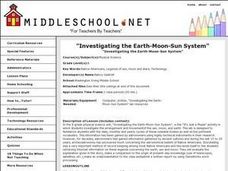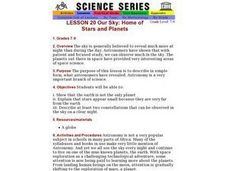Curated OER
Exploring the Night Sky: Fall/Winter
Students explain how moon phases occur. They explain three ways that the night sky has been used through history. Students locate some of the constellations in the night sky. They discuss stories and myths surrounding stars.
Curated OER
It's Written in the Stars!
Children create narrative accounts about their character traits, illustrate the constellation of each sign of the Zodiac, and write and illustrate their own creative myths about an original "Zodiac Sign". They use the computer as a...
Curated OER
Earth Science: Create a Star Clock!
Students identify and use the starts to tell time just as people had for thousands of years. They identify the stars that appear to rise in the east and set in the west, and that those stars near the North Pole appear to go in circles...
Curated OER
Types Of Nebulae
Eighth graders explore the different types of nebulae that can be found in the solar system. They view a PowerPoint presentation about the material and identify each nebulae as it is presented. Students also discuss the life cycle of a...
Curated OER
Planets Curriculum
Students complete an in-depth study of the known planets in the solar system. As a class, students identify the planets that are known in the universe, in the night sky. They explain the differences between planets and stars and the...
Curated OER
Night Sky
Young scholars discover why stars can only be seen at night. They participate in a read aloud of, "Night Sky" by Carole Stott and, "Switch on the Night" by Ray Bradbury. Using the sky objects described in the readings, they brainstorm...
Curated OER
What's Up?
Young scholars compare and contrast the various heavenly bodies found in the sky at night. They identify the moon and stars in the sky as well as how the stars form pictures called constellations. Students also experiment with...
Curated OER
How Do We Know...?
Students identify and explain how various inventions and astronomers have improved our appreciation of the universe. Students identify at least two constellations in the sky and discuss how they were used in ancient times to tell time...
Curated OER
What's Up? Astronomy Curriculum
Students study astronomy. In preparation for a field trip to a planetarium, students discuss the stars, planets, and light. They explore the importance of the north star and constellations. The Digitarium system is used to assist the...
Curated OER
How Do We Know?
Students investigate the history of astronomy and how the study of constellations has evolved since the dawn of ancient civilization. They conduct research using a variety of resources. The teacher uses demonstrations to model how the...
Curated OER
Astrology: Fact Or Fiction?
Students investigate the concept of astrology and how it evolved from history. They use the Zodiac in order to find the location of constellations in the night sky. The differences between astrology and astronomy are compared and any...
Curated OER
Gross Motor Development
Fourth graders participate in a game reflecting the solar system, stars, and rockets. They simulate how space invaders move and hit stars and rockets. They discuss how scientists study the stars and planets.
Curated OER
Exploring Stars
Fifth graders explore the life cycle of stars. They analyze small, medium, and large stars and view a video that compares the life cycles of the various sized stars. They create a flipbook movie detailing the life cycles of a star and...
Curated OER
Star Gazers
Students research stars, constellations, planets and galaxies including names, shapes, sizes, colors, patterns and ages. They suspend the stars and planets from the ceiling and change monthy to display the various constellations. As a...
Curated OER
The Moon and The Stars
Students study the moon and the stars. They explore the vocabulary associated with the moon and the stars and cultural references including the Chinese Moon Festival. They participate in reciting poems, nursery rhymes and songs related...
Curated OER
SkyServer Scanvenger Hunt
Students discover the variety and beauty of objects in the sky and the ability of a research telescope to obtain quantitative information about these objects. They use the SkyServer Navigation Tool to identify objects and record...
Curated OER
Stars and Galaxies
Eighth graders define constellations and how they are used as reference points and identify stars and constellations in the nighttime sky. They construct their own planetarium star finder and identify the location of circumpolar, zodiac,...
Curated OER
Discover!
Students design a double spiral mobile to illustrate the different stages in the life of a small-mass star like our Sun, and in the life of a large-mass star. They complete both spirals and create a small hole at the top. Next they use a...
Curated OER
Star Light, Star Bright : Exploring How Stars Are Classified
Pupils work in small groups to organize stars into different categories. They consider size, luminosity, color and temperature, organize the groups and ten report their categories to the class.
Curated OER
Determining Red-Shift in a Receding Star
Students practice manipulating algebra formulas with more than one variable. They examine the topics of velocity, wavelength and frequency. They determine the amount of red-shift in a receding star.
Curated OER
Glow in the Dark Stars and Planets
Students view a "night sky" made from glow in the dark stars. They discuss stars, planets, the sun, and constellations.
Curated OER
Astronomy
Students complete a unit of lessons on our solar system, its stars, and astronomers. They record information in a space journal, design constellations, define key vocabulary, observe the phases of the moon, and create a group planet...
Curated OER
Investigating the Earth-Moon-Sun System
Eighth graders research Native American legends involving the sun, moon, and stars and compare them to the origin of present day knowledge. They create a written report and make an oral presentation of their findings to the class.
Curated OER
Our Sky: Home of Stars and Planets
Students discover that astronomy is a branch of science that includes the study of planets, stars, and constellations.

























